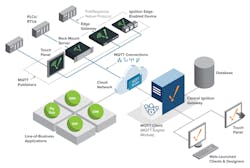If there’s one thing manufacturing environments have plenty of, it’s data. The argument surrounding the Industrial Internet of Things (IIoT) that says data needs to not just be gathered but actually be usable is not only about the analytics; it’s also about being able to get that data where it needs to be.
Increasingly, where that data needs to be is not only up in the cloud—stored in a central server for future analysis—but at the edge of the network as well. Ignition Edge, which Inductive Automation unveiled last month at the ARC Industry Forum in Orlando, is a key example of the capabilities being developed by industry.
This week, Inductive Automation formally released Ignition Edge, a lightweight, low-cost version of its flagship Ignition industrial application platform. Unlike Ignition, which is designed to work on central servers and deploy to multiple clients, the Ignition Edge products will be embedded into field and OEM devices. Together with the original Ignition platform, manufacturers can build scalable enterprise-wide systems.
“Industrial organizations need a new architecture if they really want IIoT,” said Don Pearson, chief strategy officer for Inductive Automation. “That includes collecting data near the source, at the edge of the network. It means gathering data as close to devices as possible, rather than from the SCADA system. Ignition Edge is a very affordable way to get data from the edge and into an enterprise database, where it can be leveraged for analysis and better decision-making.”
One of the products, Ignition Edge MQTT, was developed in collaboration with Cirrus Link Solutions. Inductive Automation partnered with Cirrus Link to develop MQTT modules for the original Ignition platform. MQTT, co-invented by Cirrus Link president Arlen Nipper, is an extremely lightweight pub/sub messaging transport that provides fast, bi-directional communication.
“Having the power of Ignition extend down to edge devices in the field offers a disruptive approach to how industrial network infrastructures are designed, deployed and managed,” Nipper said.
The Ignition Edge MQTT product enables publication of field device data through MQTT for more efficient, easier access to data. It turns virtually any field device, such as a touch panel or a client terminal, into a lightweight, MQTT-enabled edge gateway. The product can transmit data to any MQTT broker and supports the Sparkplug data-encoding specification.
For further explanation about MQTT and other IT technologies being leveraged for the factory floor, read “IT for Industry: Rocket Science?”
Another product, Ignition Edge Panel, enables creation of local human-machine interfaces (HMIs) for field devices. It enables edge-of-network HMI functionality with robust Ignition features, including one local client, one remote web client for mobile access, and alarming features including email notification. It includes one week of data buffering for trending and local client fallback for mission-critical applications.
Ignition Edge Enterprise acts as an agent gateway in a multi-gateway Ignition system by leveraging the Ignition Enterprise Administration Module (EAM). Features include remote backup, restoration management, centralized monitoring of performance and health metrics, and remote alarm notification. Edge Enterprise comes with up to a week of data buffering, and it can synchronize local tag history to a central Ignition historian for store-and-forward.
Also this week, Inductive Automation launched a free trial of Ignition Edge on its website.
Leaders relevant to this article:

